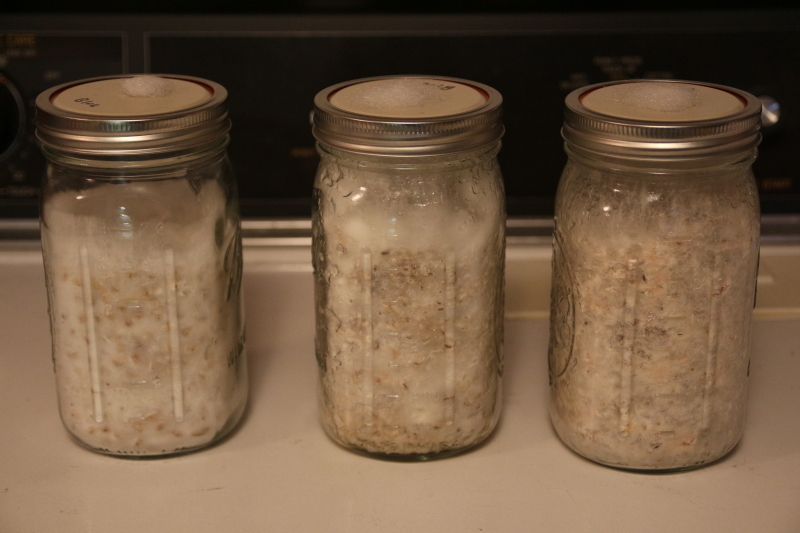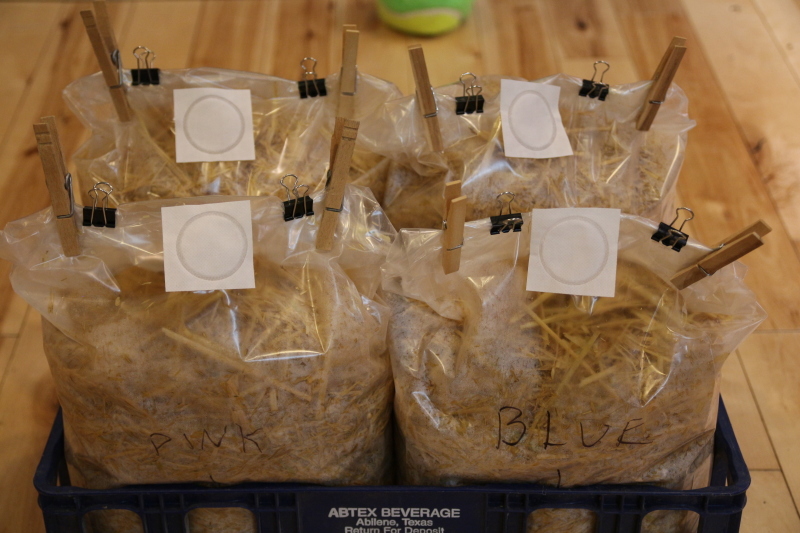I’ve lost track now of how long since I started on this, but I think it’s been 2-3 weeks since I transferred my original spawn to grain jars? All of the jars have been fully colonized except for one jar of pink oysters, which fought against some kind of contamination but seems to have gotten going again. It had some good looking growth though, so I decided to use that jar plus one jar of blue oysters (but grown on popcorn kernels) for my first attempt at fruiting. If it is too weak and fails, well if was worth a shot and I wouldn’t have gotten anything else from it anyway.
I’m using some 8" fruiting bags from ebay, and pasteurized chopped straw in a lime water bath overnight then let it drain today for about 2.5 hours. Each quart jar of spawn was split between two fruiting bags.
Now here comes the scary part… I didn’t have room inside to work on this, and knew working with the straw was going to be very messy, so I set up a table in the yard. I wiped everything down with 91% ISO as I went, but being outside has me worried about the chances of contam. Guess we’ll see?
So now I have four stuffed fruiting bags hanging out in the garage where it will be a little warmer than the basement. I had considered putting the bags in my garden but I’m worried about squirrels and such getting into them (especially when they start to fruit) so I figured the garage was safer. I’m expecting another 2-3 weeks of expansion before they’re ready to fruit, but it’s just a game of wait&see now. And assuming I get some mushrooms from this batch, I can bring it back full-circle and start a new batch of spawn (this time directly in the grain jars) from what grows.
One question I have for everyone… I have three more jars of spawn that are pretty well completely grown in (one popcorn and two rye berries). Should I put these in the refrigerator until I’m ready to transfer them to fruiting bags? I’m not sure how long they can survive at room temperature but I seem to recall they can hang out in the fridge for 3-4 months without any problem?
Maybe try to split up a long post like this the next time. For me, it seems to be a bit all over the place with different questions. Not many read through all of this.
Maybe provide some pictures of your inoculated bags, the area, grainspawn, conditions, and so on. That would be very helpful.
Just a few points:
- maybe think about using HWFPs the next time. They are easier to handle and store, “more natural” for oysters, come pre-pasteurized and are better to weight.
- be careful with lime. I always over-used it and it harmed the mycelium. Nothing grew there, everything was dead
- 70% iso is better than 90%
- don’t worry that much about contamination outside. As long as the GS is clean, oysters overcompete any contams, at least in my experience. Just use a bit more GS, that helps
- keep an eye out for insects. They love oysters, and oysters love them in return (as food! :D)
- remember, the myc needs enough air. Do you have breathing holes in the bag? And if yes, are they taped over?
- don’t store the GS in the fridge. The cold shock can age the mycelium or promote fruiting. Put them in a moderately cool room, like your basement, bathroom or closet
As I said, maybe post some pictures :) I hope, I could help you.
Not sure what happened to the color in the first photo, but here’s the growth of the three remaining jars plus my fruiting bags. I noticed there’s a LOT of moisture collecting in these jars all the sudden, I hope that’s normal?


Alright. Both the jars and bags look, how I can tell from the pics, very healthy! :)
Some moisture collection is normal, since mushrooms create water my their metabolism.
Excessive moisture can lead to bacteria, but oysters are really good in fighting them off when they colonized the jar.
Do they look yellowish-brown at the bottom? This might be a sign of stress
No the bottoms seem ok, and all this extra moisture has only shown up in the last few days as the mycelium really packed the grain. There’s not a lot of moisture in the house, we just had a evening of rain and it’s still only 42% humidity here. I’ll check again tomorrow though.
So to answer your question about the bottom color… no, all three jars look pretty much the same on the bottom as they do around the sides. The only difference I’m seeing is in the jar of pink oysters with rye berries, there is some odd orangish coloration starting to show up? Not sure what that is because as you can see in the OP (the jar on the right) the mycelium is very fully colonized in there so I’m wondering if the extra moisture being put off by the mycelium is causing the rye berries to leech something? Seems like it would be too late in the game for contamination? It doesn’t really show up in the photo but I’ll have to keep an eye on it.
[Edit] Oh I guess I did give an answer to this yesterday as well.
Hmm I thought I had posted pics of the grain spawn further along, but my last pics were only a few days after I transferred the starter spawn to the grain jars. I’ll see if I can grab some pics of what the other jars look like today.
I’ve looked into the fuel pellets, I believe that’s something I will need to use when I try growing lion’s mane or shiitakes so it is definitely in my future. The straw method seemed to be recommended for oysters on a lot of sites and it was available at the farm supply store a few blocks from my house.
I do have a bit of concern about the lime bath not being strong enough. I put in 5tbsp for 10 gallons of water, but everything warned about using gloves when handling it so you didn’t burn your skin. I did NOT use gloves, and actually reached right into the water to pull out the laundry bag of straw when I was ready to hang it for drainage (I had a garden hose beside me just in case), but I never even felt a tingling so I dunno.
Why is 70% ISO better? 91% is stronger, it’s what we use around the house for cleaning things.
No worry about insects in the garage (also another reason I didn’t want to hang the bags in the garden), but yeah, maybe I’ll move them back to the basement anyway. There are currently no holes in the fruiting bags, other than the air filter patch. My understanding is that I need to wait until the spawn has fully colonized the straw, THEN cut some holes in the bags and the exposure to oxygen causes fruiting?
And thanks for the feedback on the fridge… OK I’ll keep the other jars in the basement closet for now, although that’s not really much cooler than the rest of the house.
Part 3: breathing holes
My understanding is that I need to wait until the spawn has fully colonized the straw, THEN cut some holes in the bags and the exposure to oxygen causes fruiting?
100% correct. I didn’t know how your bags looked like and if they had a filter patch on them. Then everything is fine. Mushrooms don’t need a lot of oxygen before fruiting. Oysters only need a lot of FAE (fresh air exchange) when pinning and fruiting. If you would grow in a tent, which you don’t, then improper FAE would make them long and stemmy. Beware to keep an eye out for humidity. Anything under 70-80% will make them abort or go crispy.
OK cool so I’m still on the right track is seems. Yeah I’m aware of the humidity issue, which may be a problem here since the natural air humidity is always so low. I assumed I would have to spray more than a couple times a day, but think I can get my wife to spray them once day for me when I have to go to the office, so it’s sounding more and more like I really need to keep the bags in the house.
I tried growing outside, on my balcony, just a few days ago. I sprayed multiple times daily, and it was cool + rainy, and still they got crispy. Maybe it was the wind.
Imo, growing outdoors is only viable in spring and autumn, but not now. A garage is also pretty dry.
Maybe put a plastic bag onto them if they fruit, that might help in the meantime.
Alternatively, building a DIY grow tent is super easy and cheap. Here is mine at the end of the answer. It only costed 50 bucks or so max.
- Heavy duty shelf (30-40€)
- Plastic foil (for painting walls, 5-10€)
- Shoe trays and plant absorber blocks for sucking up excessive moisture (5-10€)
And optional/ optimally:
- An old PC fan (0€)
- Terrarium fogger (30€)
Nice setup. Unfortunately money isn’t the problem for me to set up something like this, I simply don’t have any good space to put it. My wife has 20 aquariums throughout the house, everything from 10 to 120 gallons, so you would think we would have incredibly high humidity, but nooooo.
Part 1: lime baths
I personally think that lime baths aren’t the best recommendation.
Yes, it might and will work, and doesn’t need energy for cooking huge volumes, but it is easy to overdo and then nothing will survive anymore. For those small amounts, like yours, I would recommend boiling.
Ca(OH)2 isn’t as dangerous as everyone says. Those guides just pretend that everyone is dumb, at least that’s what it feels like to me. It’s like saying “Be careful, if you use a knife then you might cut yourself” tbh.
I’m a chemist and work with lyes all the time, and sometimes I get them over my hand. Concentration and exposure time are key. Just wash your hands after that (if pure lye gets on you, act fast!). It will hurt/ tingle long before harm is done. Remember to apply cream after it, it makes soap out of your fats.
But the concentration for the lime bath is super low. It should have a pH of 9-10, which is super soft in comparison. It is basic enough to promote an environment unfavorable for contams, but not enough to “kill” everything. Oysters for example can tolerate that, bacteria can’t.
Interesting, the info I’ve been reading suggested a pH around 12. 9-10 isn’t really much at all, my tap water tests between 8.5 to 8.8.
Yeah, same. Mine is also 8 or so.
Maybe I was a bit wrong about the lime pH. I thought 10 or 11 max was the limit. pH is logarithmic, so 11 is 10x more basic than 10. That’s huge.
But if that’s the information you got, then you’re probably right :)
I just checked again, the info came from https://grocycle.com/cold-water-lime-bath-pasteurization-for-mushroom-substrate/ and they suggest reaching a pH of 11-13. I forgot pH is logarithmic so yeah you’re right about that being a big difference. Hopefully I got it high enough, all I had was an aquarium test kit for “high” pH and it only goes up to 8.8, so it barely keeps my tap water in range, and it had no hope of testing my lime bath. I’m surprised there’s no suggestions to rinse the straw after you pull it from the bath, but oh well.
Part 2: Isopropanol
Why is 70% ISO better? 91% is stronger, it’s what we use around the house for cleaning things.
70% Iso is better than pure one. I can’t exactly tell you why, but in a nutshell, 70% has more contact time with the surface and breaks the cells’ hull integrity better.
Also, plus point, when diluting it, it doesn’t smell as much and is cheaper^^
I personally also use diluted bleach (1/10) for surfaces. I grow in buckets, which I have to clean after using, and bleach is cheaper and more effective for me.


